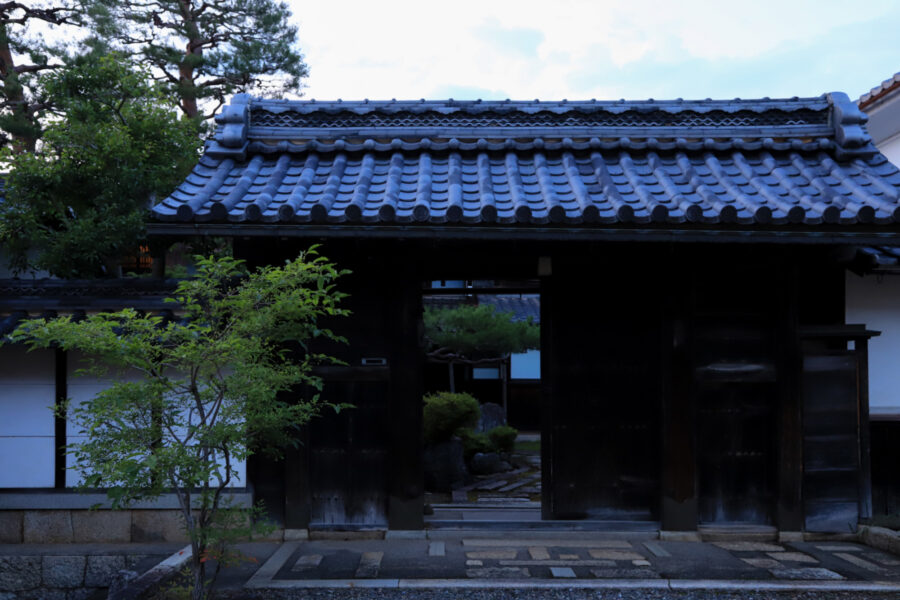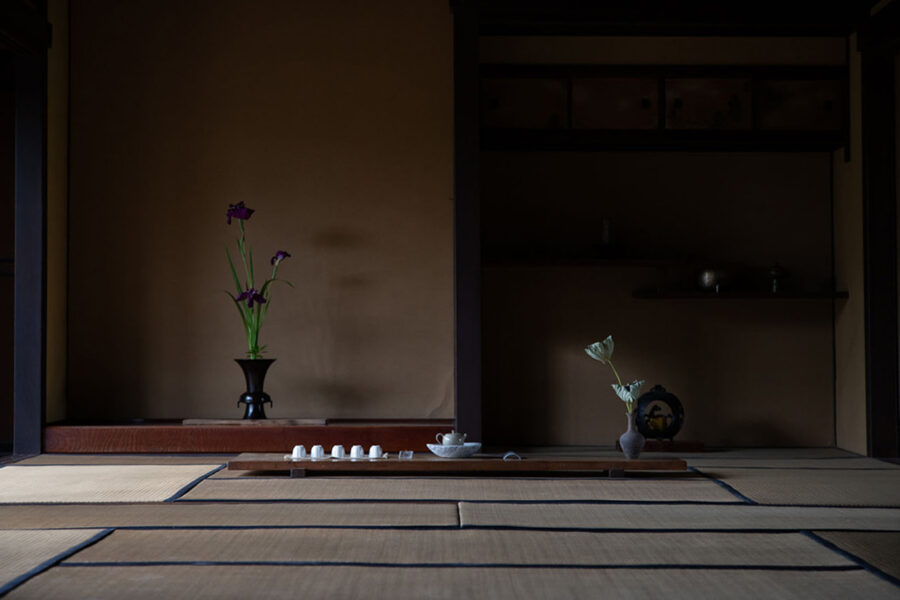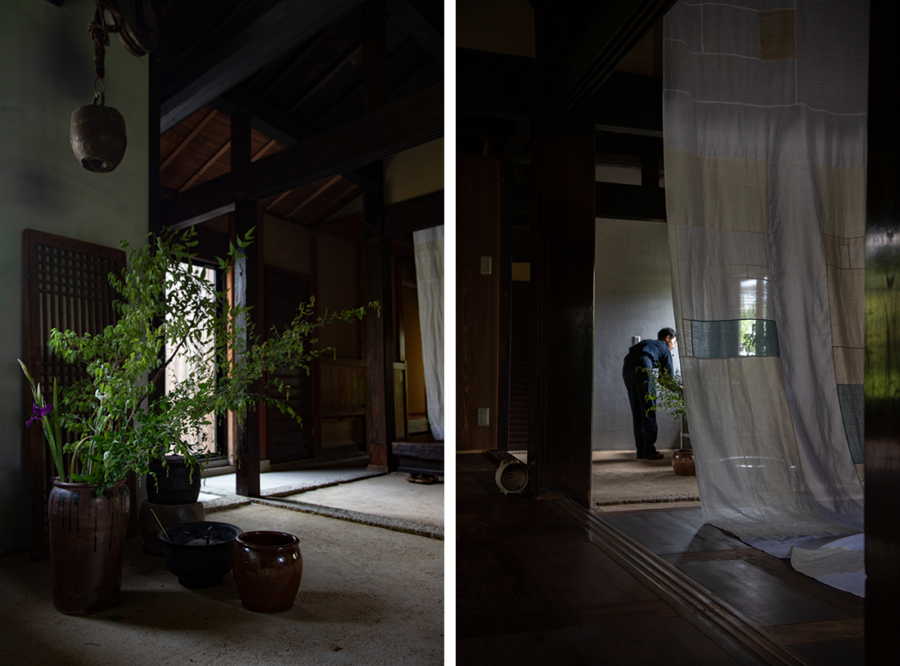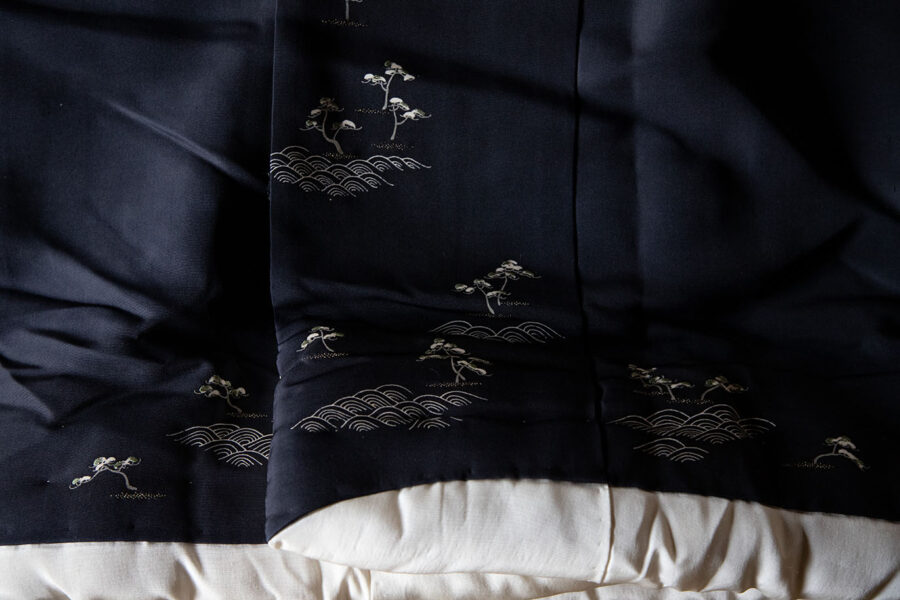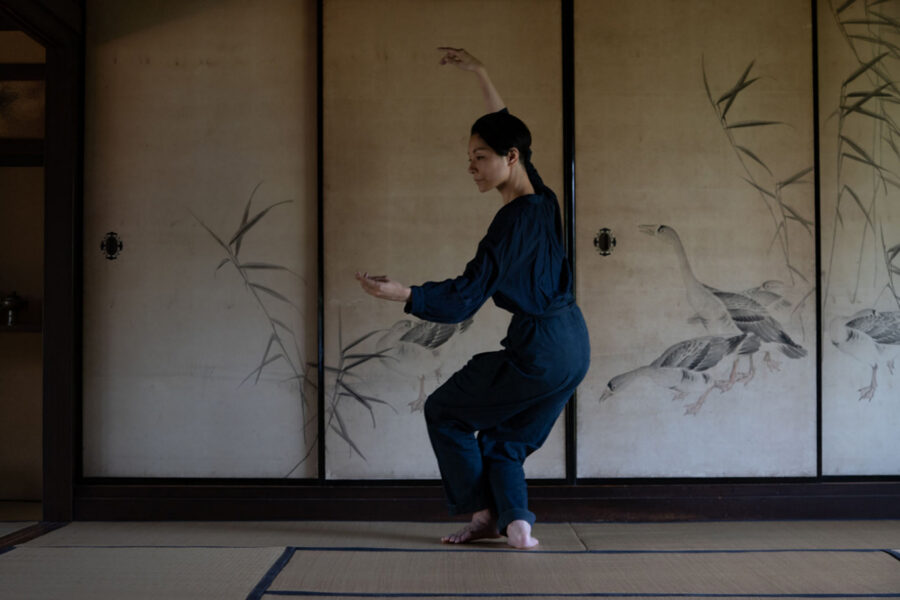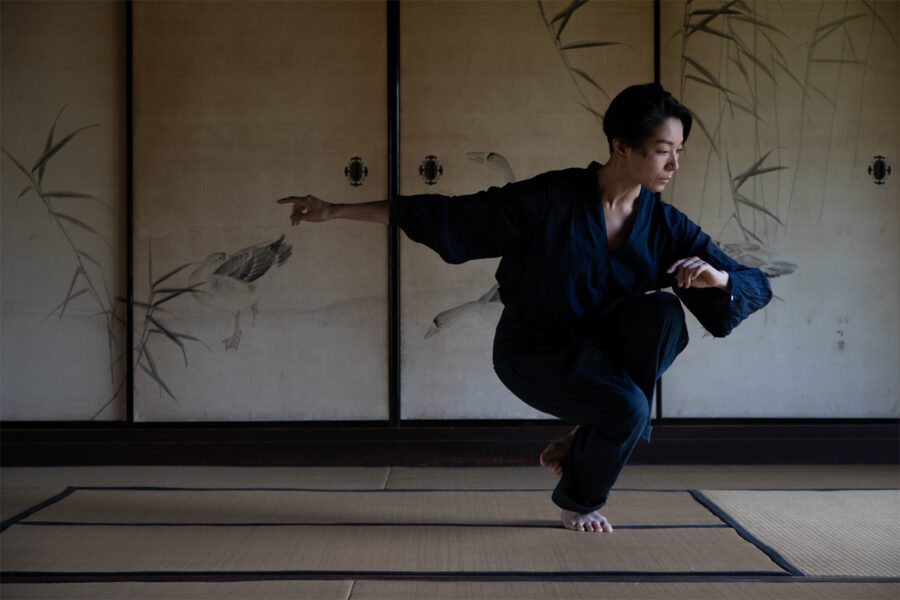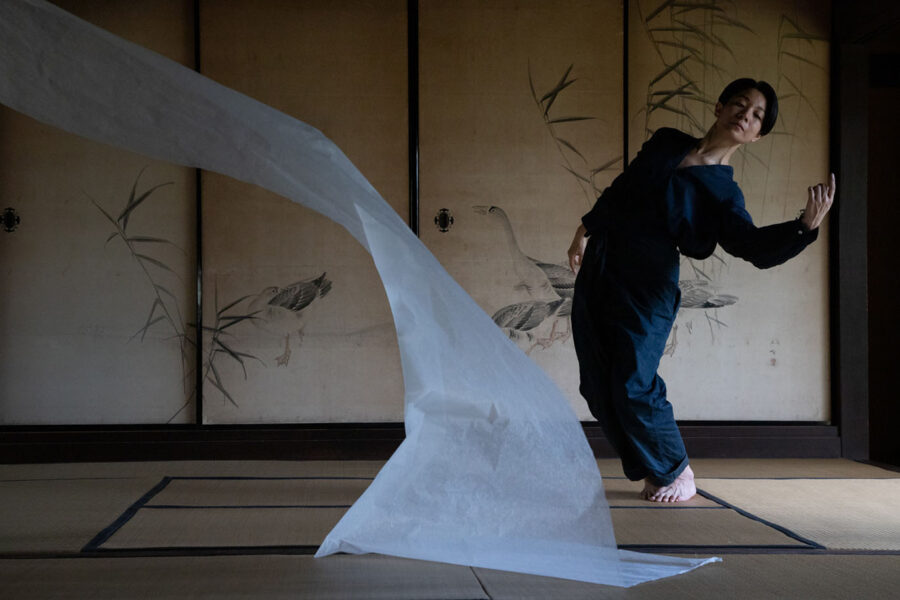
滋賀県長浜市 舞踊家 苳英里香 FUKI Erika, Dancer, Nagahama in Shiga
日本最大の湖、琵琶湖を湛える滋賀県の湖北に位置する長浜市は、古くから暮らしや文化芸術、信仰の拠点となり、ダイナミックに人々の営みが息づいてきた土地です。縄文から平安までの遺物が数多く発掘された葛籠尾崎湖底遺跡があり、古来より「神の棲む島」とされ奈良時代に行基が宝厳寺を開山、能の舞台ともなっている竹生島があります。豊臣秀吉が築いた長浜城の城下町で生まれた曳山祭は、伝統工芸芸能を結集した絢爛な装飾で「動く美術館」とも呼ばれて現在に至ります。江戸時代は養蚕が盛んになり、明治以降は最高級絹織物「浜ちりめん」の産地となりました。この地で元ちりめん問屋を営んでいた日本家屋と出会い、一目惚れして移り住み、身体哲学を探求する舞踊家の苳英里香(ふき えりか)さんを尋ねました。
堂々たる長屋門と赤松をくぐり、玄関へ。
広々とした客間へ上がると涼しい風が通り抜け、澄んだ空気が流れる。
Passing through the imposing nagaya gate and red pine tree to the entrance.
A cool breeze passes through the spacious drawing room. The air is clear.
学生時代に身体表現をしていた苳さんは、ヨーロッパでの公演で「私たちの神様は天にいるけれど、あなたの神様は大地にいるね」と言われたこときっかけに、自分自身の、そして伝統芸能のルーツに向き合ってみようとシルクロードを西から東へ辿る旅をしました。アフリカンダンス、ベリーダンス…と学び、韓国の民族舞踊に魅せられて12年が経ち、漸く日本の舞を学ぶ準備が整ったと感じたそうです。学び始めて8年になる能には深く惹かれていて「究極に研ぎ澄まされた東洋的身体性」であり、地球の中心に向かってゆく引力と重量を身体に通しながら、一度もその集中力が漏れることのない状態だといいます。能とともに始めたお花とお茶の稽古を通して、あらゆるものが空間と響き合い調和していることの美しさを学び、それを体現できる稽古場を求めていた時、この家と出会いました。「ここは東西南北がとても正確で、風向きや日の出から日没までの光の移ろい、闇に向かう時間を刻々と皮膚に染み込むように体験できます。この家で暮らし始めてから、闇の色の階層が広がり豊かに感じられるようになりました」。
お花とお茶の所作には美しい踊りがあり、花そのものの中に理想の踊りがある。
空間、道具、人への気遣いと調和がすべて身体表現の師。
There is a beautiful dance in the moves of the flower arrangement and tea ceremony,
and an ideal dance in the flowers themselves.
Care and harmony to and with space, tools and people are all masters of physical expression.
苳さんが舞い始めると、風と呼応して動く身体は人間の気配を消し、この空間に魂が備わったように感じます。「家は拡張された身体だと思います。足を擦る床の音や、古い木や布の感触に反応して、知らずと自分の動き、身体感覚が作られていきます。電気も外して蝋燭にしました。繊細なものを周りに置いたら、自分も繊細に動かないと家を傷つけてしまう。その時、自分自身のことも繊細に扱えていると気づきます。日々の暮らしを丁寧に淡々と積み上げ、そこから滲み出るものが舞台にも現れます。だから本当に家に育ててもらっていて、お仕えしますという気持ちです。数百年生きている木材に囲まれていると、その先の百年後、何をここに残せているのかという視野になり、自分はこの瞬間を借りているだけだという感覚になりました」。
身体は精神に隷属するものではなく、精神が宿る器。
日々の所作や想像力から生まれ出る身体性を大切に過ごす。
The body is not a slave to the spirit, but a vessel in which the spirit resides.
Spend time valuing the physicality that emerges from daily gestures and imagination.
韓国の伝統芸能者としての道と、まだ名前をつけることができない自分の表現を同時進行しているという苳さん。今最も眼差しが向かう先は、身体に霊性を取り戻すことだといいます。
「民族舞踊を踊っていると、日本人でありながら大陸から来たものと繋がっていると感じます。他国で踊る時は、その土地に敬意を持って互いの架け橋となりたい。これまで様々な芸能を通して、渡り来たものと土地の力が交差したところに、それぞれの色があり表現が生まれているのを体感してきました。それをいかに自分が受け取って体現できるか、よく響く状態にしておくか。ここに各地から稽古をしに来てくださる方々と共に学んでいるのは、踊りというよりも人としての在り方、身体の哲学に近いと思います。天地と繋がり自ずと生じるものを通して、最後は私たちは一つになれる。それが平和への緒になると信じています」。
蔵にあった桐箪笥に仕舞い込まれていた着物。
繊細な波と松の刺繍が裾袘にも施される。
Kimono stored in a paulownia-wood chest of drawers in a storehouse.
Delicate embroidery of waves and pine trees is also applied to the hems.
Located in the north of Shiga Prefecture, which is home to Japan’s largest lake, Lake Biwa, Nagahama City has long been a centre of life, culture, arts and faith, and a dynamic place of human activity. The city contains the Tsuzuraozaki Underwater Site, from where many relics from the Jomon to Heian periods have been excavated, as well as Chikubu Island, which has been regarded as an “island where god dwells” since ancient times, and where the priest Gyoki founded Hogonji temple in the Nara period. Chikubu Island is also the setting of a Noh play. The Hikiyama Festival was born in the town of Nagahama Castle, built by TOYOTOMI Hideyoshi, and has been called a “moving art museum” because of its dazzling decoration that brings together traditional crafts and performing arts. Sericulture flourished during the Edo period, and after the Meiji period the area became a centre of production of the highest quality silk fabric, Hama Chirimen. We visited dancer FUKI Erika, who moved to the area after falling in love at first sight with a traditional Japanese house that was formerly a chirimen wholesaler, and has been exploring her philosophy of the body.
FUKI, a student of physical expression, was told at a performance in Europe that “Our god is in heaven, but your god is on the earth.” This inspired her to travel along the Silk Road from west to east to confront her own roots, and those of traditional performing arts. She learnt African dance and belly dance among others, and after 12 years of being fascinated by Korean folk dance, she finally felt ready to learn Japanese dance. She has been deeply attracted to Noh, which she has been learning for 8 years now, and says that it is “the ultimate in refined oriental physicality”. To her, performing Noh lets her enter a state of never once losing focus, while having the gravity and weight towards the centre of the earth pass through her body. Through the practice of flower arrangement and tea ceremony, which she began along with Noh, she learnt the beauty of everything resonating and harmonising with space. When she was looking for a place to practise her arts, she came across this house. “Here the east, west, north and south are so precise that you can experience the direction of the wind, the changing light from sunrise to sunset and the hours of darkness as it seeps into your skin every second. Since I started living in this house, the gradation of darkness has become wider and richer.”
When FUKI begins to dance, it feels as if the human presence disappears from the body moving in response to the wind, and the space becomes equipped with a soul instead. “I think the house is an extended body. The sound of the floor when sliding feet, the touch of the old wood and fabric – reacting to them unconsciously creates my own movement, my own physical sensations. I removed the electricity and switched to using candles instead. If you put delicate things around you, you have to move delicately too, or you will damage the house. I then realise that I can also treat myself delicately. I build up my daily life carefully and unobtrusively, and what exudes from that is also visible on stage. So, I really feel that the house nurtures me and I serve it. Being surrounded by timber that has lived for hundreds of years gives me a perspective of what I can leave behind here a hundred years down the road, and I feel that I am only borrowing this moment.”
FUKI says she is simultaneously pursuing her path as a traditional Korean performer and expressing herself in a way that she cannot yet name. Her main focus at the moment is to regain spirituality in the body.
“When I perform folk dances, I feel connected to something from the continent, even though I am Japanese. When I dance in other countries, I want to be a bridge between us with respect for that land. Through various performing arts, I have experienced that each colour and expression is born at the intersection of what has crossed over and the power of the land. How can I receive and embody this, and how can I keep it in a state where it resonates well? What I am learning with the people who come here from all over the world to practise is not so much about dance, as about the way we are as human beings and the philosophy of the body. Through the connection with above and with the ground and what comes naturally there, we can become one in the end. I believe that this will become key to peace.
Photography by Tomoko Hayashi
Text by Tomomi Takezoe
Translation :Naoko Mabon (WAGON)

